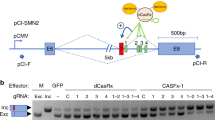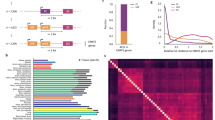Abstract
Although adeno-associated virus (AAV)-mediated gene therapy has been hindered by the small viral packaging capacity of the vector, trans-splicing AAV vectors are able to package twice the size of the vector genome. Unfortunately, the efficiency of current trans-splicing vectors is very low. Here we show that rational design of the gene splitting site has a profound influence on trans-splicing vector-mediated gene expression. Using mRNA accumulation as a guide, we generated a set of efficient trans-splicing vectors and achieved widespread expression of the 6-kb ΔH2-R19 mini-dystrophin gene in skeletal muscle of mdx mice, a model for Duchenne muscular dystrophy. The dystrophic phenotype was ameliorated in both adult and aged mice. This demonstrates the use of trans-splicing vectors to efficiently express a large therapeutic structural protein. This strategy should be applicable to other large therapeutic genes or large transcription regulatory elements.
This is a preview of subscription content, access via your institution
Access options
Subscribe to this journal
Receive 12 print issues and online access
$209.00 per year
only $17.42 per issue
Buy this article
- Purchase on Springer Link
- Instant access to full article PDF
Prices may be subject to local taxes which are calculated during checkout



Similar content being viewed by others
References
Duan, D., Yue, Y. & Engelhardt, J.F. in Lung Biology in Health and Disease, Gene Therapy in Lung Disease (ed. Albelda, S.M.) 51–92 (Marcel Dekker Inc., New York, NY, 2002).
Kay, M.A. et al. Evidence for gene transfer and expression of factor IX in haemophilia B patients treated with an AAV vector. Nat. Genet. 24, 257–261 (2000).
Carter, B.J. Adeno-associated virus vectors in clinical trials. Hum. Gene Ther. 16, 541–550 (2005).
Dong, J.Y., Fan, P.D. & Frizzell, R.A. Quantitative analysis of the packaging capacity of recombinant adeno-associated virus. Hum. Gene Ther. 7, 2101–2112 (1996).
Duan, D. et al. Circular intermediates of recombinant adeno-associated virus have defined structural characteristics responsible for long term episomal persistence in muscle. J. Virol. 72, 8568–8577 (1998).
Duan, D., Yan, Z., Yue, Y. & Engelhardt, J.F. Structural analysis of adeno-associated virus transduction intermediates. Virology 261, 8–14 (1999).
Yue, Y. & Duan, D. Double strand interaction is the predominant pathway for intermolecular recombination of adeno-associated viral genomes. Virology 313, 1–7 (2003).
Yan, Z., Zhang, Y., Duan, D. & Engelhardt, J.F. Trans-splicing vectors expand the utility of adeno-associated virus for gene therapy. Proc. Natl. Acad. Sci. USA 97, 6716–6721 (2000).
Sun, L., Li, J. & Xiao, X. Overcoming adeno-associated virus vector size limitation through viral DNA heterodimerization. Nat. Med. 6, 599–602 (2000).
Nakai, H., Storm, T.A. & Kay, M.A. Increasing the size of rAAV-mediated expression cassettes in vivo by intermolecular joining of two complementary vectors. Nat. Biotechnol. [see comments] 18, 527–532 (2000).
Duan, D., Yue, Y. & Engelhardt, J.F. Expanding AAV packaging capacity with trans-splicing or overlapping vectors: a quantitative comparison. Mol. Ther. 4, 383–391 (2001).
Chao, H., Sun, L., Bruce, A., Xiao, X. & Walsh, C.E. Expression of human factor VIII by splicing between dimerized AAV vectors. Mol. Ther. 5, 716–722 (2002).
Reich, S.J. et al. Efficient trans-splicing in the retina expands the utility of adeno-associated virus as a vector for gene therapy. Hum. Gene Ther. 14, 37–44 (2003).
Yan, Z., Zak, R., Zhang, Y. & Engelhardt, J.F. Inverted terminal repeat sequences are important for intermolecular recombination and circularization of adeno-associated virus genomes. J. Virol. 79, 364–379 (2005).
Xu, Z. et al. Trans-splicing adeno-associated viral vector-mediated gene therapy is limited by the accumulation of spliced mRNA but not by dual vector coinfection efficiency. Hum. Gene Ther. 15, 896–905 (2004).
England, S.B. et al. Very mild muscular dystrophy associated with the deletion of 46% of dystrophin. Nature 343, 180–182 (1990).
Harper, S.Q. et al. Modular flexibility of dystrophin: implications for gene therapy of Duchenne muscular dystrophy. Nat. Med. 8, 253–261 (2002).
Sironi, M. et al. Analysis of splicing parameters in the dystrophin gene: relevance for physiological and pathogenetic splicing mechanisms. Hum. Genet. 109, 73–84 (2001).
Chao, D.S. et al. Selective loss of sarcolemmal nitric oxide synthase in Becker muscular dystrophy. J. Exp. Med. 184, 609–618 (1996).
Cartegni, L., Chew, S.L. & Krainer, A.R. Listening to silence and understanding nonsense: exonic mutations that affect splicing. Nat. Rev. Genet. 3, 285–298 (2002).
Ibrahimel, C., Schaal, T.D., Hertel, K.J., Reed, R. & Maniatis, T. Serine/arginine-rich protein-dependent suppression of exon skipping by exonic splicing enhancers. Proc. Natl. Acad. Sci. USA 102, 5002–5007 (2005).
Li, X. & Manley, J.L. Inactivation of the SR protein splicing factor ASF/SF2 results in genomic instability. Cell 122, 365–378 (2005).
Halbert, C.L., Allen, J.M. & Miller, A.D. Adeno-associated virus type 6 (aav6) vectors mediate efficient transduction of airway epithelial cells in mouse lungs compared to that of aav2 vectors. J. Virol. 75, 6615–6624 (2001).
Duan, D., Yue, Y., Yan, Z. & Engelhardt, J.F. A new dual-vector approach to enhance recombinant adeno-associated virus-mediated gene expression through intermolecular cis activation. Nat. Med. 6, 595–598 (2000).
Liu, M. et al. Adeno-associated virus-mediated micro-dystrophin expression protects young mdx muscle from contraction-induced injury. Mol. Ther. 11, 245–256 (2005).
Yue, Y. et al. Microdystrophin gene therapy of cardiomyopathy restores dystrophin-glycoprotein complex and improves sarcolemma integrity in the mdx mouse heart. Circulation 108, 1626–1632 (2003).
Yue, Y., Skimming, J.W., Liu, M., Strawn, T. & Duan, D. Full-length dystrophin expression in half of the heart cells ameliorates beta-isoproterenol-induced cardiomyopathy in mdx mice. Hum. Mol. Genet. 13, 1669–1675 (2004).
Ervasti, J.M. & Campbell, K.P. Membrane organization of the dystrophin-glycoprotein complex. Cell 66, 1121–1131 (1991).
Acknowledgements
We thank A. Dusty Miller for the AAV-6 packaging plasmids. We thank Scott Q. Harper and Zhuping Xu for helpful discussion and technical assistance. This work was supported by grants from the National Institutes of Health (AR-49419, D.D.) and the Muscular Dystrophy Association (D.D. and J.S.C.).
Author information
Authors and Affiliations
Corresponding author
Ethics declarations
Competing interests
The authors declare no competing financial interests.
Supplementary information
Supplementary Fig. 1
Adult mdx mice used in this study displayed more severe muscle pathology. (PDF 312 kb)
Supplementary Fig. 2
Mini-dystrophin expression is observed only in AV.Donor.60 and AV.Acceptor.60 co-infected muscle but not in single vector infected muscle. (PDF 283 kb)
Supplementary Fig. 3
Absence of CD4+ and CD8+ T cells in AV.Donor.60 and AV.Acceptor.60 co-infected muscle. (PDF 230 kb)
Supplementary Fig. 4
Mini-dystrophin expression restores the entire DGC complex but not nNOS to the sarcolemma. (PDF 488 kb)
Supplementary Fig. 5
AV.Donor.60 and AV.Acceptor.60 co-infection in aged mdx EDL muscle does not reduce muscle pathology neither does it increase specific force. (PDF 593 kb)
Supplementary Fig. 6
AAV-6 infects all muscle fiber types, but with a trend towards preferential transduction of fast fibers, in dystrophic mdx limb muscle. (PDF 806 kb)
Rights and permissions
About this article
Cite this article
Lai, Y., Yue, Y., Liu, M. et al. Efficient in vivo gene expression by trans-splicing adeno-associated viral vectors. Nat Biotechnol 23, 1435–1439 (2005). https://doi.org/10.1038/nbt1153
Received:
Accepted:
Published:
Issue Date:
DOI: https://doi.org/10.1038/nbt1153
This article is cited by
-
Prinzipien der translationalen Gentherapie für neuromuskuläre Erkrankungen
Der Nervenarzt (2022)
-
Application of prime editing to the correction of mutations and phenotypes in adult mice with liver and eye diseases
Nature Biomedical Engineering (2021)
-
The sustained expression of Cas9 targeting toxic RNAs reverses disease phenotypes in mouse models of myotonic dystrophy type 1
Nature Biomedical Engineering (2020)
-
Adeno-associated virus vector as a platform for gene therapy delivery
Nature Reviews Drug Discovery (2019)
-
Gene Therapy for Heart Failure: New Perspectives
Current Heart Failure Reports (2018)



